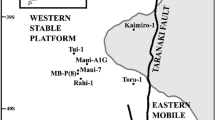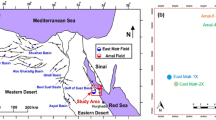Abstract
The Upper Miocene Qawasim Formation is an important hydrocarbon reservoir in the Nile Delta Province. This paper presents the diagenetic features and the reservoir characteristics of this formation based on conventional core analysis performed on the El-Tamad-2 well. The Qawasim Formation is consisted of low compacted, poorly cemented, massive, and laminated sandstones with gradual upward facies change to tightly cemented bioclastic and dolomitic sandstones. The sandstones are capped by shallow marine bioclastic limestones followed by the open marine Globigerina wackestone and mudstone facies of the Pliocene Kafr El-Sheikh Formation. The channel-fill massive and laminated sandstones are classified as subarkose arenites with well-preserved primary intergranular porosity and good secondary porosity due to the dissolution of feldspars. In addition, they have low clay volume, well-connected pore spaces, and hence very good reservoir quality. On the other hand, the bioclastic and dolomitic sandstones were affected by the diagenetic alterations. Dolomite cement blocked the intergranular pores and reduced the primary porosity, while the dissolution of bioclasts and feldspars increased the secondary porosity. The reservoir quality decreases dramatically with increasing the marine influence from the channel-fill sandstones to dolomitic and bioclastic sandstones, shallow marine bioclastic limestone, and marine mudstone facies. The massive sandstones at the bottom of the upper part of the Qawasim Formation represent the best reservoir quality interval with excellent porosity and permeability values and have proven to be the main target for future exploration activities.









Similar content being viewed by others
References
Abdel Aal A, Price R, Vital J, Sharallow J (1994) Tectonic evolution of the Nile delta, its impact on sedimentation and hydrocarbon potential. Proc. 12th EGPC Exploration and Production Conference, Cairo, Egypt, V.1: 19–34
Barakat G (1982) General review of the petroliferous provinces of Egypt with special emphasis on the geological setting and oil potentialities. TAP Report 83–1, Cairo University-Massachusetts Institute of Technology, 87 p.
Berner R (1981) A new geochemical classification of sedimentary environments. J Sed Petrol 51:359–365
Braunsdrof N, Kittridge M, Khalil A, Rosenquist M (2008) Rock property trend curves in the Nile Delta: an essential step in quantitative interpretation studies. Mediterranean Offshore Conference, Alex. Egypt, 5 p
Cassidy S, Shann M (2004) Evaluating thinly bedded pay potential in the Sidi Salim Formation of the Temsah Field, a case history. Mediterranean Offshore Conference, Alex, Egypt, 6 p
Corex (2007) Lithological, petrographical and core analysis studies on the side wall core samples from El-Tamad-3 well. (Internal Reports).
Deibis S, Futyan A, Ince D, Morley R, Seymour W, Thompson S (1986) The stratigraphic framework of the Nile Delta and its implications with respect to the region’s hydrocarbon potential. In: The 8th Exploration Conference, Egyptian General Petroleum Corporation, Cairo.
Dolson J, Shann M, Matbouly S, Harwood C, Rashed R, Hammouda H (2001) The petroleum potential of Egypt. AAPG Mem 74:453–482
Dunham R (1962) Classification of carbonate rocks according to depositional texture. In Ham, W.E. (editors): Classification of carbonate rocks. AAPG, M. 1.
EGPC (Egyptian General Petroleum Corporation) (1994) Nile Delta and North Sinai fields, discoveries and hydrocarbon potentials (a comprehensive overview). Egyptian General Petroleum Corporation, Cairo, Egypt, 387 p
El-Sisi Z, Sharaf L, Yehia H, Dawood A, Hassouba A (1996) Source of clastic supply to the Sidi Salem and Abu Madi reservoirs of the Nile Delta: a province study. Proc. 13th EGPC Exploration and Production Conference, Cairo, Egypt, V.1: 291–296
EREX (2006) Biostratigraphy and lithostratigraphy of El-Tamad-1 well. (Internal Reports).
Flügel E (2004) Microfacies of carbonate rocks, analysis, interpretation and application. Springer- Verlag, Berlin, 996 p
Froelich P, Klinkhammer G, Bender M (1979) Early oxidation of organic matter in pelagic sediments of the eastern equatorial Atlantic: suboxic diagenesis. Geochim Cosmochim Acta 43:1075–1090
Halim A, Fouad O, Worku T, Khaled A, Fawzy H (1996) Aspects of reservoir potential of the Miocene-Pliocene sequences in North Alexandria and the surrounding areas, offshore Nile Delta, Egypt. Proc. 13th EGPC Exploration and Production Conference, Cairo, Egypt. V. 1: 224–241
Kamel H, Eita T, Sarhan M (1998) Nile delta hydrocarbon potentiality, Egypt. Proc. 14th EGPC Exploration and Production Conference, Cairo, Egypt, V.1: 485–503
Khidir A, Catuneanu O (2010) Reservoir characterization of Scollard- age fluvial sandstones, Alberta foredeep. Mar Pet Geol 27:2037–2050
Lowe D (1982) Sediment gravity flows II. Depositional models with special reference to the deposits of high-density turbidity currents. J Sediment Petrol 52:279–297
Mathisen M (1984) Diagenesis of Plio-Pleistocene non-marine sandstones, Cagayan Basin, Philipines: early development of secondary porosity in volcanic sandstones. In: Clastic Diagenesis, AAPG Memoir 37: 177–193
Pettijhon F (1975) Sedimentary rocks, 3rd edn. Harper and Row, New York, 628 p
Rizzini A, Vezzani F, Coccocetta V, Milad G (1978) Stratigraphy and sedimentation of Neogene-Quaternary section in the Nile Delta area, (A.R.E). Mar Geol 27:327–348
Ross D, Uchupi E (1977) Structure and sedimentary history of northeastern Mediterranean Sea-Nile cone area. AAPG Bull 61:872–902
Said R (1981) The geologic evolution of the River Nile. New York, Springer, 151 p
Said A, Rizk R, Tebaldi E (2004) Cyclostratigraphy as new approach to determine the depositional style of Serravallian-Tortonian in Temsah, Wakar and Port Fouad Marine fields, north Port Said, Egypt. Mediterranean Offshore Conference, Alex. Egypt, 26 p
Salem A, Ketzer J, Mora S, Rizk R, Al-Aasm I (2005) Diagenesis and reservoir quality evolution on incised-valley sandstone: evidence from the Abu Madi gas reservoirs (Upper Miocene), the Nile Delta basin, Egypt. J Sediment Res 75:572–584
Sarhan M, Hemdan K (1994) North Nile delta structural setting trapping and mechanism. Egypt. Proc. 12th EGPC Exploration and Production Conference, Cairo, Egypt, V.1:1–18
Shaaban F, Lutz R, Littke R, Bueker C, Odisho K (2006) Source rock evaluation and basin modeling in the NE Egypt (NE Nile Delta and Northern Sinai). J Pet Geol 29(2):103–124
Sharaf L, Awad S, Khaled K, Rashed A (2004) Sedimentology and reservoir characterization of the Abu Madi level III sandstones, Abu Madi gas field, Nile Delta, Egypt. Proc. 7th International Conference on the Geology of the Arab World, Cairo University, p. 457–481
Vandre C, Cramer B, Gerling P, Winsemann J (2007) Natural gas formation in the western Nile Delta (Eastern Mediterranean): thermogenic versus microbial mechanisms. Org Geochem 38:523–539
Worden R, Burley S (2003) Sandstone diagenesis: recent and ancient. Blackwell, London, 664 P
Zaghloul Z, Elgamal M, Shaaban F, Yousef A (2001) Plates interactions and petroleum potentials in the Nile Delta. Proceedings of the 1st conference on the Deltas, Modern and Ancient, 41–53.
Acknowledgments
The authors would like to thank the Egyptian General Petroleum Corporation (EGPC) and Mansoura Petroleum Company, Egypt for providing the data and samples for this study. The authors are also grateful to the Corex Services (Cairo, Egypt) for providing the facilities to carry out this research. The authors would also like to thank the anonymous reviewers who provided useful comments that improved the manuscript.
Author information
Authors and Affiliations
Corresponding author
Rights and permissions
About this article
Cite this article
Leila, M., Kora, M.A., Ahmed, M.A. et al. Sedimentology and reservoir characterization of the Upper Miocene Qawasim Formation, El-Tamad Oil Field onshore Nile Delta, Egypt. Arab J Geosci 9, 17 (2016). https://doi.org/10.1007/s12517-015-2088-9
Received:
Accepted:
Published:
DOI: https://doi.org/10.1007/s12517-015-2088-9




